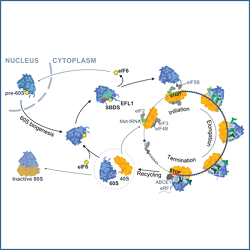
Protein synthesis is a cyclical process in which ribosome components assemble to translate mRNA into protein, disassemble upon completion and are recycled back into further rounds of assembly. This multi-step process is normally very carefully controlled, through mechanisms which are still being determined. New research from the Warren lab in CIMR has shed new light on the specific role of the ribosome anti-association factor eIF6, which binds to free ribosomal 60S subunits to hold them in an inactive state. By combining structural (cryo-EM) and functional approaches (in Drosophila and transgenic mice overexpressing eIF6), Dr Pekka Jaako and colleagues have shown how the interplay between eIF6 and its counteracting regulators of the 60S ribosomal subunit (SBDS and EFL1) couple ribosome assembly and recycling. Mutations in the genes that encode SBDS and EFL1 cause an inherited leukemia predisposition disorder called Shwachman-Diamond syndrome and this new research provides further insight into the molecular mechanisms of this rare disease.

